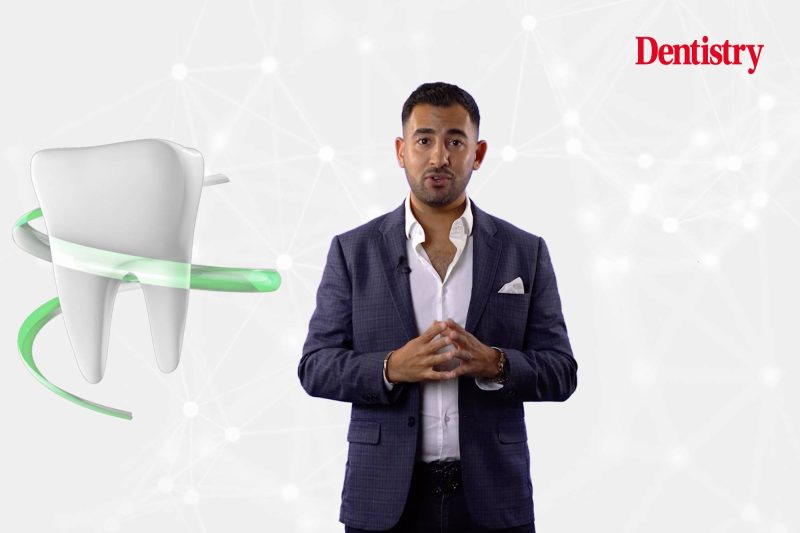Dr Nikhil Sethi demystifies bonding and adhesion

https://www.youtube.com/watch?v=NCjMS0cXplU
‘In my experience, bonding and adhesion are one of the most difficult subjects to teach and one of the most poorly understood in our profession.’ This is how Dr Nik Sethi, dentistry thought leader and director of Elevate Education, introduces his recent video presentation which aims to demystify bonding and adhesion.
The video lays out Nik’s fail-safe process for durable bonds and in this short blog we’ll take a look at some of the key problems he highlighted and the solutions he suggests for secure and predictable bonding.
Remove biofilm using air abrasion
Chewing food and drinking liquids leads to the accumulation of plaque and leaves teeth (completely) covered in biofilm. Yet, it is rare for dentists to disclose a tooth before proceeding with adhesive dentistry. A disclosing solution will reveal the extent of the biofilm coverage on the tooth and air abrasion is the perfect procedure to achieve a really clean surface that will make bonding more predictable and secure.
The problem with dentine bonding
Enamel is over 90% mineral, which makes it ideal for bonding. When phosphoric acid is applied to the tooth surface it is demineralised, creating etch patterns that can be washed and dried as much as is necessary for the resin to infiltrate and form a durable hybrid layer. However, dentine is a different story.
Dentine is only 60-70% mineral and is a living structure full of collagen fibres and water. This means that phosphoric acid will only demineralise 60-70% of the surface dentine, leaving the collagen and water remaining.
If the dentine is then overdried, the collagen will collapse and provide an insufficient surface for bonding. This increases the risk of post-procedure sensitivity and premature bond failure. On the other hand, if the dentine is not dried enough, the solvent will not be capable of removing enough water to allow the resin to seep in and form the hybrid layer. The water is trapped and the bond will break down.
This vast variability in clinical conditions and subsequent success means that an approach that moves away from etching dentine is necessary.
Protocol to avoid over-etching the dentine
If using a total-etch system, carefully following a specific protocol that avoids over-etching the dentine can secure reliably great results. This can be achieved by applying a viscose etching gel to the enamel borders first and setting a timer for 15 seconds. After 15 seconds, flood the cavity with etching gel onto the dentine and set the timer for a further 15 seconds. This process ensures that the enamel has been etched for the full 30 seconds, but the dentine has only been etched for 15 seconds. This protocol has been shown to prevent over-etching the dentine, reducing the risk of collagen fibre collapse.
Timing is everything
After etching, washing and drying, the bonding agent should be applied as soon as possible. The solvent in the bonding agent is key to evaporating the water in the dentinal tubules. However, dispensing the bonding agent too early will lead the solvent to dissipate.
Therefore, the bonding agent should be shaken vigorously and dispensed just before it’s required. Once applied, fresh bonding agent should be continuously applied for 30 seconds. The fresh solvent ensures that any excess water evaporates.
Self-etching bonding agents: the way forward
Universal or self-etching bonding agents use compounds like MDP (methacryloyloxydecyl dihydrogen phosphate) to demineralise the top surface, creating a pseudo-chemical reaction that forms a highly durable bond to the dentine. The lack of etching and washing eliminates the risk of over-drying.
This chemical process has been found to provide a durable bond strength that lasts five to 10 years, a significant improvement to the six to 18 months when the dentine is etched.
I prefer universal bonding agents or self-etching bonding agents over a total-etch system because I believe they avoid the variability of etching dentine. Remember though that MDP does not provide a durable enough bond to enamel, so etching gel will still be required on the enamel borders.
Bonding agents are available in one bottle solutions such as G-Premio BOND, or if you prefer to separate the wet chemistry from the dry chemistry the G2-BOND Universal two bottle system, is available and this protocol has been shown to have the best long-term durability for dentine bonding.
To listen to Nik’s step-by-step fail-safe process for successful bonding, whether using a total-etch system, a one bottle universal agent or a two-bottle system, watch his video presentation here.
To discover more about GC’s bonding options visit: www.gc.dental/europe/en/products/gpremiobond and www.gc.dental/europe/en/products/g2bonduniversal.
You can explore Nik’s advice and tips on a whole range of dental procedures in his full series now available here on FMC Box Office.







